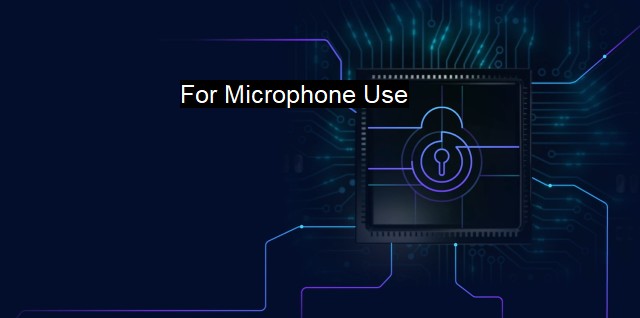What is For Microphone Use?
Why You Need 'For Microphone Use' Antivirus Software: Protecting Your Computer System from Cyber Attacks via Audio Devices
In the cybersecurity context, the concept of "for microphone use" pertains to settings, permissions, measures, and policies related to the use and access to a device's microphone. Microphone use is related to voice recording, communication apps, virtual assistance services, and a variety of other applications. while microphones have numerous productive uses, their misuse can implicate privacy and security concerns.In an era where numerous applications and services request microphone access, ensuring that this access is not mistreated is pivotal in safeguarding individual privacy and preventing potential cybersecurity threats. Access to a device's microphone means that conversations, meetings, and personal details could be recorded and stored without the users' knowledge. This information can then be used maliciously, such as blackmailing, spying, or identity theft. From a cybersecurity perspective, unauthorized and misuse of microphones is a major concern.
Antivirus programs play an essential role in defending the permission settings of our devices' microphones. They thwart hacking attempts and bar applications from accessing microphones without clear consent. These antivirus tools are programmed to continuously monitor and limit the suspicious activities attempted by various programs in our devices. Regular checks and updates conducted by the antivirus enhance security and enhance device protection from any malicious intent, especially concerning the misuse of the microphone, thus ensuring heightened cybersecurity.
Another method is to secure a device’s microphone by tailoring the settings in such a way to enable access to trustworthy apps only. it's also crucial to assess updates and changes in application rules and contexts, as even the most trustworthy apps might change privileges over time ‐ possibly leading to privacy encroachment.
Encryption also plays a significant role in microphone cybersecurity. When the data recorded from a microphone is encrypted, it adds an additional security layer, even when the data is intercepted; it would not be meaningful unless decrypted using a proper key. Therefore, the encryption of any data being transmitted from your microphone provides substantial protection against eavesdropping attacks.
To heighten individual control over microphone access, some tools also offer notifications alerting users when an app or a service attempts to use it. With notifications, the users will have more control and can take immediate action if unauthorized access is detected.
User education is also paramount. Knowing the potential threats, understanding how antivirus software assists in protection, and being cautious about permission settings can significantly reduce the risk of microphone exploitation. Emphasizing microphone cybersecurity can ensure privacy and keep covert or unwanted activities from occurring.
Software developers also share this responsibility. Creating applications with privacy-preserving dispositions helps secure user data by default. Offering customizable and clear permissions settings can also enhance user understanding of their microphone data usage, providing them with means to control their privacy and lending more trust towards application developers.
“for microphone use” in a cybersecurity context is primarily about controlling, monitoring, and securing access to the microphone in a digital device. Various techniques, such as configuring settings, encryption and decryption, antivirus programs, user alerts, and user education, can assist in safeguarding our microphone’s use. This is not simply about stopping strange noises or echo in a voice call; it concerns preventing potential data leaks, ensuring personal privacy, and maintaining robust cybersecurity measures in an increasingly connected digital world.

| | A | | | B | | | C | | | D | | | E | | | F | | | G | | | H | | | I | | | J | | | K | | | L | | | M | |
| | N | | | O | | | P | | | Q | | | R | | | S | | | T | | | U | | | V | | | W | | | X | | | Y | | | Z | |
| | 1 | | | 2 | | | 3 | | | 4 | | | 7 | | | 8 | | |||||||